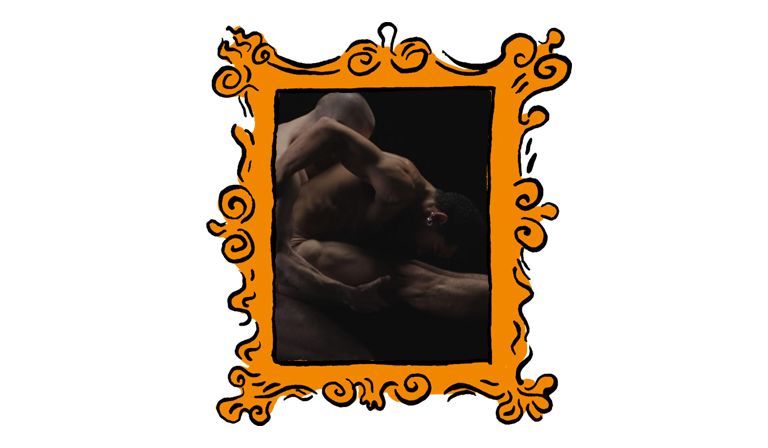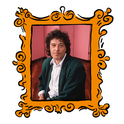It’s the dress rehearsal at the Polish National Radio Symphony Orchestra (NOSPR); the plain-clothed orchestra and choir are running through Karol Szymanowski’s A Body for Harnasie. Above them hangs a 750kg sculpture that’s made of two metal frames covered in translucent gauze. It spins slowly in the air, the jaws of the frame opening and closing. On the gauze is projected a series of flickering videos—hands touching bodies, colours bleeding down the screen. And then, suddenly, a desktop background.
“I don’t think we need the orchestra anymore,” says Edward Gardner, principal conductor of the London Philharmonic Orchestra. He’s working with a Polish orchestra for the first time here in Katowice. On 6th March it will transfer to London’s Southbank Centre. The orchestra and choir shuffle offstage. It’s now up to the tech team, who have been working overnight and sit crowded over a computer in the audience, to finish fine-tuning the AI that forms both the set and the dancers for this ballet.
AI is killing art, it’s often said. Illustrations made by smart technology, such as Dall-E, flood the internet. Algorithms are now regularly used as a cost-cutting way to write music, literature and journalism. The backlash has been intense: last year’s strike by the Writers Guild of America was focused on a demand that AI not be used to replace writers. Some would argue that using AI at all in creative work could encourage those who would rather use an algorithm than pay artists.
“We do have to think carefully,” acknowledges Ewa Bogusz-Moore, general and programme director of NOSPR, when we speak about the risk of using AI after the rehearsal. The NOSPR stage is far too small to accommodate the instruments and dancers, so hiring live performers wouldn’t have been possible, she stresses. No job opportunities have been lost here.
Besides, real dancers were used—just earlier in the process. Three were filmed performing dances choreographed by the renowned Wayne McGregor. Visual artist Ben Cullen Williams trained the AI on these dancers and on drone-captured footage from the Tatra mountains (where Szymanowki’s ballet is set) to create unreal scenes of rippling mountains and twisting bodies.
I ask Cullen Williams why he chose to use AI instead of, say, Photoshop to create these effects. He argues that algorithms allow for new, exciting developments that a human artist might not think of. AI, he tells me, can “push the aesthetics into new unexpected ways that are potentially closer to humanity’s understanding of the world.”
“I’ve got this preoccupation about our relationship to a digital image,” he adds. “They’re so unrealistic… But if you think of what you did yesterday, most of it is kind of hazy and a bit of a blur.” The algorithms can replicate our own half-real, half-invented memory of events. In Szymanowski’s ballet, a shepherd is about to marry his fiancée when she is stolen away by a robber. Although McGregor has cast one female dancer and two men, it’s deliberate that we can’t tell who is the robber and who is the shepherd. Instead, their movements become increasingly unreal, replicating more the emotions at play than the actual story.
It’s a pioneering attempt to use AI in this way—and it could go wrong. Although Bogusz-Moore first thought of the project during Covid, while ruminating on AI and its impacts, they only had four days to put the final thing together at the NOSPR. “Even when we were doing the run-through, we were also discovering what’s happening with this sculpture, how things work, whether there’s synchronisation or not,” she tells me.
That evening—last Monday, in fact—I return for the performance. The concert hall, which opened 10 years ago, cost €70m to build. It seats 1,800 people and has the largest organ of any concert hall. (The NOSPR used to be run out of what had been a Communist party conference building, but that wasn’t good for sound, our guide tells us—its main purpose was to “make sure the audience’s applause reached people on stage”.)
And then: the seats are mostly full. Someone whispers that “le tout Poland” is here. The lights go dim.
On the gauzy screen, we see three dancers, embracing each other and performing non-AI-enhanced ballet, alongside aerial footage of snowy mountains. Then dots fill the screen and the mountains undulate as though dancing along with the music. The dancers become hazier and their movement becomes odder. The camera zooms in on arms gripping hairy stomachs, hands on skin, a silver earring in a man’s ear, a tattoo. Colours of the mountains drip down the gauze while the screen unfolds. Colours of the mountains drip down the gauze. As the music swells to a climax, the screen goes dark.
AI hasn’t just been a technical solution to a problem. As Bogusz-Moore describes it to me, the algorithm is a “third artist”. The flickering, eerie video footage works well alongside the music. There are no cardboard peaks and performers in rustic dress. But some simple video footage, enhanced by an algorithm, makes you feel all the passion and fury and chaos playing out across the cold Polish mountains.
How to make artists of AIs
A ballet in Poland is using computers in novel ways—to support, rather than supplant, the dancers’ creativity
February 29, 2024











